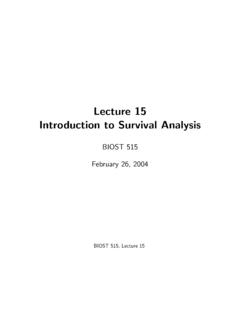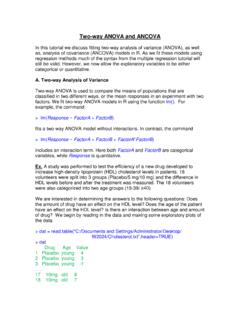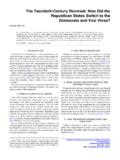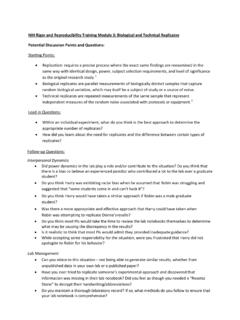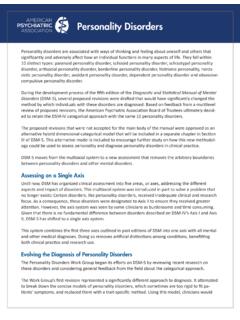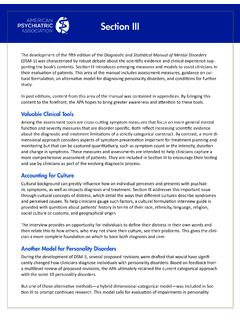Transcription of Missing-data imputation
1 CHAPTER 25 Missing-data imputationMissing data arise in almost all serious statistical analyses. In this chapter wediscuss a variety of methods to handle missing data , including some relatively simpleapproaches that can often yield reasonable results. We use as a running example theSocial Indicators Survey, a telephone survey of New York City families conductedevery two years by the Columbia University School of Social Work. Nonresponsein this survey is a distraction to our main goal of studying trends in attitudes andeconomic conditions, and we would like to simply clean the dataset so it could beanalyzed as if there were no missingness. After some background in Sections , we discuss in Sections our general approachof random discusses situations where the Missing-data process must be modeled(this can be done in Bugs) in order to perform imputations data in R and BugsIn R, missing values are indicated by NA s.
2 For example, to see some of the datafrom five respondents in the data file for the Social Indicators Survey (arbitrarilypicking rows 91 95), we typeR codecbind (sex, race, educ_r, r_age, earnings, police)[91:95,]and getR outputsex race educ_r r_age earnings police[91,] 1 3 3 31 NA 0[92,] 2 1 2 37 1[93,] 2 3 2 40 NA 1[94,] 1 1 3 42 1[95,] 1 3 1 24 NAIn classical regression (as well as most other models), R automatically excludesall cases in which any of the inputs are missing ; this can limit the amount ofinformation available in the analysis, especially if the model includes many inputswith potential missingness.
3 This approach is called a complete-case analysis, andwe discuss some of its weaknesses Bugs, missingoutcomesin a regression can be handled easily by simply in-cluding the data vector, NA s and all. Bugs explicitly models the outcome variable,and so it is trivial to use this model to, in effect, impute missing values at become more difficult when predictors have missing values. For example,if we wanted to model attitudes toward the police, given earnings and demographicpredictors, then the model wouldnotautomatically account for the missing valuesof earnings. We would have to remove the missing values, impute them, or modelthem. In Bugs, regression predictors are typically unmodeled and so Bugs does notknow how to draw from a predictive distribution for them.
4 To handle missing datain the predictors, Bugs regression models such as those in Part IIB need to beextended by modeling (that is, supplying distributions for) the input Missing-data mechanismsTo decide how to handle missing data , it is helpful to know whythey are consider four general missingness mechanisms, movingfrom the simplest tothe most completely at variable ismissing completely at randomif the probability of missingness is the same for all units, for example, if eachsurvey respondent decides whether to answer the earnings question by rollinga die and refusing to answer if a 6 shows up. If data are missing completely atrandom, then throwing out cases with missing data does not bias your at missingness isnotcompletely at random, as canbe seen from the data themselves.
5 For example, the different nonresponse ratesfor whites and blacks (see Exercise ) indicate that the earnings questionin the Social Indicators Survey is not missing completely more general assumption, missing at random, is that the probability a variableis missing depends only on available information. Thus, if sex, race, education,and age are recorded for all the people in the survey, then earnings is missingat random if the probability of nonresponse to this questiondepends only onthese other, fully recorded variables. It is often reasonable to model this processas a logistic regression, where the outcome variable equals1 for observed casesand 0 for an outcome variable is missing at random, it is acceptable to exclude themissing cases (that is, to treat them as NA s), as long as the regression controlsfor all the variables that affect the probability of missingness.
6 Thus, any modelfor earnings would have to include predictors for ethnicity, to avoid missing -at-random assumption (a more formal version of which is some-times called the ignorability assumption) in the Missing-data framework is thebasically same sort of assumption as ignorability in the causal framework. Bothrequire that sufficient information has been collected that we can ignore theassignment mechanism (assignment to treatment, assignment to nonresponse). that depends on unobserved is no longer atrandom if it depends on information that has not been recorded and this in-formation also predicts the missing values. For example, suppose that surly people are less likely to respond to the earnings question, surliness is predictiveof earnings, and surliness is unobserved.
7 Or, suppose that people with collegedegrees are less likely to reveal their earnings, having a college degree is predic-tive of earnings, and there is also some nonresponse to the education , once again, earnings are not missing at familiar example from medical studies is that if a particular treatment causesdiscomfort, a patient is more likely to drop out of the missingness isnot at random (unless discomfort is measured and observedfor all patients).If missingness is not at random, it must be explicitly modeled, or else you mustaccept some bias in your that depends on the missing value , a particularly dif-ficult situation arises when the probability of missingnessdepends on the (po-tentially missing ) variable itself.
8 For example, suppose that people with higherearnings are less likely to reveal them. In the extreme case (for example, all per-sons earning more than $100,000 refuse to respond), this is calledcensoring, buteven the probabilistic case causes METHODS THAT DISCARD DATA531 Censoring and related Missing-data mechanisms can be modeled (as discussed inSection ) or else mitigated by including more predictors in the missing -datamodel and thus bringing it closer to missing at random. For example, whitesand persons with college degrees tend to have higher-than-average incomes, socontrolling for these predictors will somewhat but probably only somewhat correct for the higher rate of nonresponse among higher-income people. Moregenerally, while it can be possible to predict missing values based on the othervariables in your dataset, just as with other Missing-data mechanisms, this situ-ation can be more complicated in that the nature of the Missing-data mechanismmay force these predictive models to extrapolate beyond therange of the ob-served impossibility of proving that data are missing at randomAs discussed above, missingness at random is relatively easy to handle simplyinclude as regression inputs all variables that affect the probability of missing -ness.
9 Unfortunately, we generally cannot be sure whether data really are missingat random, or whether the missingness depends on unobservedpredictors or themissing data themselves. The fundamental difficulty is that these potential lurk-ing variables are unobserved by definition and so we can never rule them generally must make assumptions, or check with referenceto other studies (forexample, surveys in which extensive follow-ups are done in order to ascertain theearnings of nonrespondents).In practice, we typically try to include as many predictors as possible in a modelso that the missing at random assumption is reasonable. For example, it maybe a strong assumption that nonresponse to the earnings question depends onlyon sex, race, and education but this is a lot more plausible than assuming thatthe probability of nonresponse is constant, or that it depends only on one of Missing-data methods that discard dataMany missing data approaches simplify the problem by throwing away data .
10 Wediscuss in this section how these approaches may lead to biased estimates (one ofthese methods tries to directly address this issue). In addition, throwing away datacan lead to estimates with larger standard errors due to reduced sample analysisA direct approach to missing data is to exclude them. In the regression context, thisusually meanscomplete-case analysis: excluding all units for which the outcomeor any of the inputs are missing . In R, this is done automatically for classicalregressions ( data points with any missingness in the predictors or outcome areignored by the regression). In Bugs, missing values in unmodeled data are notallowed, so these cases must be excluded in R before sending the data to Bugs, orelse the variables with missingness must be explicitly modeled (see Section ).

